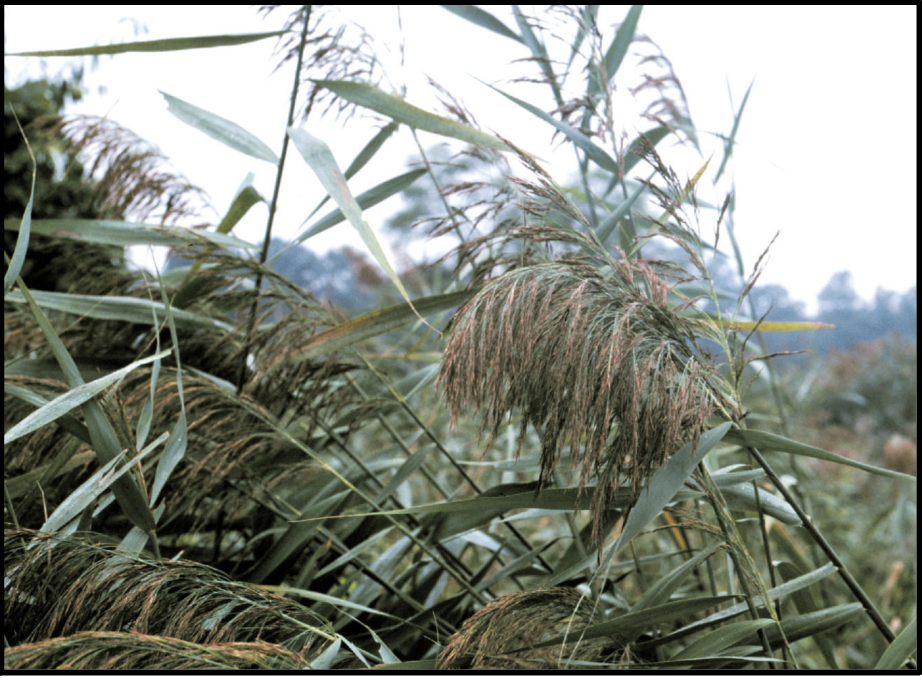Love our lakes, rivers and wetlands? Stop aquatic hitchhikers

Sigrid Resh/KISMA KISMA’s portable boat wash unit with the Isle Royale Ranger III
By
- Sigrid Resh/KISMA KISMA’s portable boat wash unit with the Isle Royale Ranger III
- Joseph McCauley, US Fish& Wildlife Service/Bugwood.org Invasive phragmites
- Alison Fox, University of Florida, Bugwood.org Above, Eurasian watermilfoil
- Sigrid Resh European frog-bit plant with characterist white flower
- USDA APHIS PPQ, Bugwood.org Grass carp
KISMA, MTU
For the past few summers, the Keweenaw Invasive Species Management Area (KISMA) boat wash crew has been traveling to boat launches throughout Baraga, Houghton, and Keweenaw Counties with a portable boat wash station to educate boaters on the importance of preventing the spread of aquatic invasive species (AIS).
AIS come in many forms, from European watermilfoil to round gobies, European frog-bit, invasive phragmites, spiny waterfleas, and zebra mussels. All these species are considered invasive because they are non-native and pose significant threats to the economy, ecology, and human components of water bodies and wetlands throughout our region.
AIS can disrupt aquatic ecosystems and outcompete native animals and plants for space and resources. AIS infestations can also reduce native fish and waterfowl populations and impede boating and other recreational activities.

Joseph McCauley, US Fish& Wildlife Service/Bugwood.org Invasive phragmites
The most important actions you can take to help protect our state’s water bodies and wetlands are familiarizing yourself with AIS, never dumping unused live bait, and properly cleaning your boat and other recreational gear after each use to prevent the spread of these harmful invasive species.
Step 1. Know your AIS
The first step is educating yourself and others on the invasive species in your area and the threats they pose to our lakes, rivers, and wetlands. The AIS listed below are categorized by whether or not they are already present within KISMA.
AIS present within
KISMA and/or

Alison Fox, University of Florida, Bugwood.org Above, Eurasian watermilfoil
Lake Superior:
• Eurasian watermilfoil (Myriophyllum spicatum) — This plant forms dense mats of vegetation that change the waterbody’s ecology and interfere with recreation. Found in multiple areas of the Portage Waterway. To learn more about Eurasian watermilfoil, visit KISMA’s website (https://www.mtu.edu/kisma/aquatic-wetland-species/eurasian-watermilfoil/).
• Invasive Phragmites (Phragmites australis subsp. australis) – This tall invasive grass readily forms monocultures and is commonly found in wetlands, ditches, swales, and along the banks of streams and ponds banks. It has a limited distribution in KISMA. To learn more about invasive Phragmites, visit KISMA’s website (https://www.mtu.edu/kisma/aquatic-wetland-species/invasive-phragmites/).
• Purple loosestrife (Lythrum salicaria) – A wetland species with spike-shaped stalks which produce many small, purple flowers. One plant can produce two million wind-dispersed seeds, resulting in this species quickly spreading and creating a monoculture in ecosystems it invades. To learn more about purple loosestrife, visit KISMA’s website (https://www.mtu.edu/kisma/aquatic-wetland-species/purple-loosestrife/).
• Spiny waterflea (Bythotrephes longimanus) – This zooplankton disrupts natural food chains and foul fishing lines. It has been found in Gratiot Lake.

Sigrid Resh European frog-bit plant with characterist white flower
• Round goby (Neogobius melanostomus) – These fish have voracious appetites, and an aggressive nature allows these small fish to dominate native species.
• Zebra mussels (Dreissena polymorpha) – These mollusks disrupt natural food webs, clog pipes and pose human health risks. Eradicated from Isle Royale dock but in Lake Superior.
• Rusty crayfish (Faxonius rusticus) – This former bait species is very aggressive, allowing it to outcompete native fish and crayfish and disrupts lake beds, seriously impacting vegetation.
• Viral Hemorrhagic Septicemia (Novirhabdovirus sp.) – Viral Hemorrhagic Septicemia (VHS) is an easily-spread virus which causes fish to bleed out and can spread to and kill more than 25 different species.
AIS not yet found

USDA APHIS PPQ, Bugwood.org Grass carp
within KISMA and/or Lake Superior:
• European frog-bit (Hydrocharis morsus-ranae) – European frog-bit (EFB) resembles miniature water lilies and forms dense mats which float on the water’s surface. While EFB has not yet been found within Baraga, Houghton, or Keweenaw County, notable infestations exist in the St. Mary’s River on the eastern side of the Upper Peninsula and in northern Wisconsin’s Oconto County. To learn more about EFB, visit KISMA’s website (https://www.mtu.edu/kisma/aquatic-wetland-species/european-frog-bit/).
• Invasive carp (Hypophthalmichthys nobilis, Hypophthalmichthys molitrix, Ctenopharyngodon idella, and Mylopharyngodon piceus) – Though none of the four species of invasive carp have made it to Lake Superior yet, everyone should keep an eye out for these fish, which not only reduce native fish populations but can also seriously injure humans as a result of their habit of jumping several feet out of the water.
Step 2. Never Dump Bait
Many invasive species, such as the rusty crayfish, were introduced to our waters when anglers who used them as bait discarded unused bait into lakes and rivers where they did not belong. Anytime you dump bait, you risk introducing non-native species to our waters. Seemingly harmless minnows, worms, and even microscopic plants and animals can cause serious damage when introduced to an ecosystem where they have no natural limiting factors.
Step 3. Clean, Drain, Dry
Before leaving a boat launch, clean your boat, trailer, and equipment by removing any visible plants, animals, and residue, then dispose of them in the trash or on dry land. Drain all water from the bilge, live wells, and ballast tanks and disinfect when possible. Dry your boat thoroughly to help ensure any remaining aquatic species have perished. One of the most effective ways to prevent the transfer of AIS from the waterbody you just left to another waterbody that hasn’t been invaded yet is by following the clean, drain, and dry procedure.
Visit KISMA’s website (https://www.mtu.edu/kisma/) to view the upcoming boat washes and other KISMA events. The portable boat wash unit KISMA uses at our boat washes is provided by the National Park Service. The US Forest Service and the Great Lakes Restoration Initiative supply additional funding for KISMA’s boat wash crew.











